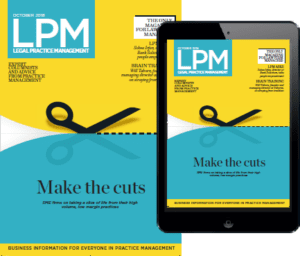
It’s how clients feel that matters
It’s not just about what firms deliver for their clients, but how they deliver it that can make the difference in an increasingly competitive market, says Nick Hayne, head of professional services at Quiss.
When it comes to attracting and retaining clients, the difference between success and failure for law firms will typically hinge not on the legal knowledge or technical expertise within the firm, but on the quality of service provided; how did they make the client feel throughout.
In the world of IT managed service providers, the same is largely true. Despite what marketing might say, the technical ability across firms is similar. So, the quality of service delivered and desire to go the extra mile to resolve every problem, should be the deciding factor when choosing an IT partner.
It is this realisation that makes customer satisfaction scores incredibly important for a business such as Quiss. This Customer Satisfaction Score (CSAT) is a customer experience metric that measures happiness with a product, service, or customer support interaction through a customer satisfaction survey that simply asks: “How satisfied were you with Quiss?”
We have worked hard to improve the experience delivered to every user and every client, and this effort is paying dividends. Our CSAT score for quarter one of 2023 for our service desk saw 97% of respondents rate their interaction as being good or excellent.
The improvements we have delivered required us to focus on key considerations, including:
Empathy. Customers want to be heard and understood – it’s important to approach each interaction with empathy and genuine concern for the customer’s needs.
Responsiveness. Customers expect a prompt response to their enquiries, complaints or issues, which requires our service desk team to respond quickly and resolve issues as fast as possible.
Knowledge. Customers want to receive accurate information and guidance, which requires us to ensure our service desk team has a deep understanding of the products and services we support.
Personalisation. Customers appreciate when their individual needs and preferences are considered, which is why we use customer data to personalise our team’s interactions.
Communication. Recognising effective communication is crucial for good customer service – we ensure our team are clear, concise and courteous in all their interactions.
Professionalism. We understand our customers expect professional conduct and demeanour from our service desk team, which we work hard to deliver in all situations.
Accountability. Our service desk team take ownership of customer issues and commit to resolving them, while openly admitting and correcting any mistakes we may have made.
Engagement. Once a customer issue has been addressed, we follow up to ensure that the resolution was satisfactory, which demonstrates our commitment to customer satisfaction and builds trust.
Improvement. We recognise customer service is an ongoing process, always with room for improvement, which is why we undertake CSAT surveys and use the results to shape our service.
Although these are all important considerations and transferable to any business, including law firms, we are never satisfied. We strive to continuously improve. It helps us optimise processes, stay competitive, adapt to change and foster a culture of innovation and excellence.
This focus on client satisfaction, not only helps us more easily achieve our goals and objectives, but most importantly, it helps our clients in their everyday working life, which is the number one reason we strive to do better and check regularly whether we are or not.

Expectations and communication – managing client relationships
Osprey Approach’s marketing manager, Amy Bruce, reflects on episode two of the company’s ‘Build Better Habits’ webinar series – with a focus on the right approach to client relationships.
For the second episode of Osprey Approach’s Build Better Habits webinar series, we were joined by Aftab Bose, editor of LPM, Sarah Charlton, CEO of law firm Eaton Evans Morris, and Gab Santos, national sales manager at InfoTrack. Our expert panel shared their knowledge and insight to provide practical tips and advice on how SME law firms can manage client relationships effectively with the right approach and mindset.
How do firms implement a client-focused mindset?
We began by asking our panel what a client-focused mindset means for modern law firms and the collective response was to ensure that clients are at the heart of all business decisions. Santos commented: “decisions are often made from an operational perspective first… but they’re not thinking from the client’s perspective.
“Everything [should] start with empathy. Unless you’re putting yourself in someone else’s shoes, it’s hard to be client focused.”
Bose agreed, pointing out that the quality of customer service delivery is one of the few things firms can control, and that: “Law firms have a unique model, especially in certain practice areas, that they’re not always able to guarantee an outcome. This means that your competitive advantage then shifts to the quality of service you deliver.”
What role can legal software play?
Bose referred to data from the 2022 LPM Frontiers report, which found that “the top item on the tech investment agenda for most SME law firms this year is customer relationship management technology – so client-focused tools are very much in focs.
“What’s important is to make sure when firms do invest in tech, that it’s integrated across their systems – to optimise the technology properly.”
Charlton agreed and said that integrating digital tools, and relying on Osprey Approach, helps them to aim towards an Amazon-like client experience. “We don’t have deep pockets like Amazon, but we use Osprey combined with other products, to replicate some service elements and it’s not that expensive.”
Legal software can provide flexibility to better manage workloads, avoid burnout, and reduce costly manual administration. Santos pointed out: “Legal technology allows lawyers to complete admin tasks and save on billable time, which allows them to communicate with clients with a human element. However, technology is not a substitute for a human interaction. It’s okay for firms to do 80% of the communication through automated milestones, emails, and reminders, though the human element is what’s going to make the difference.”
Eight habits law firms should adopt
The panel agreed that modern law firms should focus on eight key habits when implementing a client-focused strategy:
- Define a service level agreement (SLA)
To ensure accountability across the firm, expectations need to be clear, and creating an agreement that states how you’re going to communicate with clients is key, as Santos explained: “I don’t see it in firms often, but when I do it’s very successful, and that is setting up and abiding by an agreement of how you plan to service your clients.” Bose agreed and added: “What’s worked well for firms is having a separate team – perhaps a customer success role – checking in independently with the client at different points along their journey.”
- Choose your value proposition
Firms need to consider why clients would choose them over competitors. Charlton suggested considering wider business goals and purpose, including sustainability and environmental impact, offering apprenticeships, and helping the local community, or becoming a B-Corp firm to show commitment.
- Accountability
It’s important that firms communicate their goals and SLAs to the wider team and ensure they’re reminded regularly of what’s expected to ensure accountability. Santos believes that leadership needs to empower employees to provide a higher level of service and “that will only happen once you set expectations and consistently communicate those to your staff.”
- Reward staff
To reinforce the behaviour firms expect, it’s important to reward staff for achieving goals and improving performance. Charlton said that at her firm, the staff who receive good reviews are rewarded, which helps to instil a client-focused culture across the firm.
- Align values with success measures
To help reward employees and incentivise change, it’s important to measure the firm’s success towards the goal. Bose warned that current measures of success don’t always align to a client-focused strategy and pointed out: “Billable hours tend to be the measure of success, but if you pivot away from that and look at reviews and service delivery, you’ll gradually move towards a client-focused team.”
- Keep data hygienic
When using technology to enhance the client service, it’s important to ensure the data you input is cleansed and accurate. Bose explained how quality data can be used to inform creative ways of using your technology but added: “The opposite is true if the data isn’t hygienic; pretty much everything else will be a mess and take extra time. If you have clean data, then the potential is limitless.”
- Hire people from different sectors
For appropriate roles, Charlton advised that firms could look to hire individuals who have a client-focused – rather than a legal sector – background and said that her firm “targets people who have worked in hospitality because first impressions count.”
- Incentivise word of mouth
Santos pointed out that a recommendation from a client is the best way to build credibility and highlight the quality of service and suggested: “Put your solicitors’ reviews on your website, and learn from the feedback to understand what is and isn’t working for you.”
Who is responsible for ensuring client-focused habits stick?
The panel had differing views on this point, but a common theme is that the mindset needs to be a priority for it to be successful.
Santos said that a culture shift can only work if it comes from the top down and suggested that firms should “identify who at the top of your organisation has the client-focused traits you’re looking for and can effectively communicate and lead by example. It’s important to have a clear strategy and then make sure people are held accountable.”
Charlton agreed that top down is ideal but added: “You can spread the mindset from the middle. It’s all about what’s acceptable and what isn’t. Even if you don’t have buy-in from senior partners from the get-go, if the rest of the firm prioritise the client, then the business can become successful because everyone has been client-focused.”
Implement client-focused business habits for long-term success
To implement a client-centric culture across SME law firms, it’s important to have a clear strategy, a defined agreement on what’s expected, measurable performance metrics, and the right digital tools to provide support for the team so they can deliver an empathetic but profitable service.
Having a client-focused culture is one of four habits that we’ve outlined that which modern law firms should adopt for long-term success. We’ve covered all four habits in our Build Better Habits webinar series, which is now available to watch on-demand.
Osprey Approach provides an all-in-one, practice, and case management software solution to high-street and multi-branch law firms. With over 30 years’ experience in the legal software sector, its software solution and dedicated partnership helps make running a law firm easier.
Most Popular

Where are the challenges for SME law firm leadership changing?

The leading annual picture of SME law firms' changing strategic priorities
TA Triumph-Adler provides tailored support to meet compliance requirements

Law firms undertaking identity verification checks must register as an ASCP

Robust onboarding processes are fundamental to effective risk prevention

Osprey Approach's webinar explores the benefits of a digital-first approach

The power of collaborative technology
Document management and bundling systems can improve your firm’s client experience, internal communications and agility, says Lisa Walsh, director of marketing and business development, Bundledocs.
Over the past few years, businesses have had to adapt their ways of working. As companies began remote working and subsequently turned to a hybrid model, the expectation of employees and clients and requirements of courts and government organisations have changed. The technology sector adapted to these needs leading to an influx of new solutions within the legal sector.
The emergence of new technologies should not be viewed as a hindrance by law firms but rather as an effective way for firms to improve their employee relations and build relationships with their clients.
Enhanced communication
With legal technology, firms can now create and share documents with their clients in a fraction of the time it would have previously taken. A study conducted by Bloomberg Law found that almost “nine out of 10 attorneys reported that legal technology improves the services they provide to clients and is crucial to meeting client demands”. Clients can now receive their documents in minutes via email as opposed to the lengthy process of traditional postal methods.
The ability to share documents in real time reduces the overall time spent communicating back and forth between both parties and leads to a timelier process of benefit to both the firm and the client.
Accessible
Previously law firms stored their files on premise, leading to the requirement of employees to be physically present in the office to prepare documentation for clients and court. Additionally, due to a large number of physical files within offices, employees wasted valuable time searching for relevant documents.
With the emergence of cloud-based technology solutions, files can now be stored on the cloud and employees can access the required files in minutes on any device from any location. This approach facilitates a flexible way of working ensuring that employees can work in collaboration with their team to source and create documents whether they are based in the office or at another location.
Improved agility
As new technologies continue to emerge law firms need to adapt rapidly to keep up with expectations. A study by Lexion found that 72% of the legal professionals they surveyed believed that ‘technology helps to increase efficiencies. The implementation of legal technology within your firm helps to increase agility by reducing the time spent by in-house legal professionals on creating bundles and documents.
Our solution currently supports real-time collaboration where users can work on the same bundle at the same time. When changes are made to the document the other collaborator will see the changes immediately.
As we look to the future of legal firms, collaborative technology will remain at the forefront as an important asset to firms by reducing repetitive tasks, promoting collaboration and making the industry more accessible globally.
Most Popular

Where are the challenges for SME law firm leadership changing?

The leading annual picture of SME law firms' changing strategic priorities
TA Triumph-Adler provides tailored support to meet compliance requirements

Law firms undertaking identity verification checks must register as an ASCP

Robust onboarding processes are fundamental to effective risk prevention

Osprey Approach's webinar explores the benefits of a digital-first approach

Automating your expertise – where to begin?
Legal document automation solutions are making it easier than ever to streamline workflows and reduce the amount of time spent on repetitive manual processes, says Kaden Smith, director of inside sales, EMEA, at NetDocuments.
By automating tasks such as generating contracts, agreements, applications, opinions, pleadings, or entire sets of documents, you can increase both the volume and value of the service you deliver to clients, customers, and business stakeholders.
However, not all automation solutions are well-suited for the rigours of legal work, and it can be a challenge to get started as well as ensure you’re receiving the maximum benefits from document and workflow automation technology.
A recently published guide by NetDocuments offers insight into how automation is solving common challenges impacting law firms of all sizes, corporate legal departments, and legal professionals in the public sector. It also examines what to look for in a technology solution that will grow with your firm and how to develop a plan for getting started.
What is legal document automation?
Automation refers to using technology to execute tasks, processes, and workflows — either in part or in their entirety — minimising the need for human time and effort. Legal document automation streamlines the tedious, labour-intensive processes and manual tasks necessary for legal document work, such as data entry, information or service intake requests, bulk document creation, and more.
Solve your firm’s top document and workflow challenges
Regardless of your practice or area of focus, the amount of time involved in doing even simple manual tasks can put an immense amount of pressure on your workforce, especially for growing law firms looking to increase their client base and legal departments trying to keep pace with the demands of the business.
Automation technology can help your organisation significantly reduce repetitive work as well as deliver other benefits, such as:
- Build custom web- or app-based forms for matter or project intake
- Better serve your clients or business stakeholders
- Create large volumes of high-quality, error-free documents
- Automate complex legal logic in your documents
- Increase efficiency to reduce labour costs
- Stay ahead of the competition
- Modernise your practices and workflows
- Free up time for higher-value work
If you’re ready to move away from manual processes and improve the quality of your outcomes, download “Automate Your Expertise! Where to Begin”.
Let NetDocuments help you automate your expertise
As the world’s #1 trusted cloud-based content management and productivity platform, NetDocuments helps legal professionals do their very best work. Our solutions are designed from the ground up with legal work in mind, helping your team create and manage high volumes of documents with ease while also providing the level of security required for sensitive and privileged information.
Request a demo today to discover how our PatternBuilder document and workflow automation solution can help you easily replicate and automate your unique templates and processes, so they’re done the right way — your way — every time.
Most Popular

Where are the challenges for SME law firm leadership changing?

The leading annual picture of SME law firms' changing strategic priorities
TA Triumph-Adler provides tailored support to meet compliance requirements

Law firms undertaking identity verification checks must register as an ASCP

Robust onboarding processes are fundamental to effective risk prevention

Osprey Approach's webinar explores the benefits of a digital-first approach

Become a digital-first business or lose ground
A digital-first firm puts its clients and customers at the heart of everything it does, says Nick Hayne, head of professional services at Quiss.
Given the expertise and experience of Quiss in the legal sector, it was hardly surprising that Osprey Approach, providers of the renowned all-in-one legal accounting, practice and case management software should seek our opinion, when shaping their product for the future.
When developing your cloud-based legal software, it’s critical to identify and resolve the persona of the intended users, much like we do when we tailor our managed IT services to our law firm clients.
The first step in creating a product or service that is attractive to those in the legal sector, who typically need to operate at peak efficiency and productivity if increased profitability is to be realised, is to recognise the importance of a ’digital-first mindset’.
A digital-first mindset is about using technology to put the customer first – essentially creating a customer-centric culture. It means constantly looking to improve the user experience and ensuring that customer needs – rather than the path of least resistance – guide every decision made.
Digital-first means approaching any new challenge or opportunity with the assumption that the solution should be as digital as possible. This approach ensures businesses that adopt a digital-first mindset can stay ahead of the curve and can capitalise on the latest technologies.
Using the appropriate technology allows firms to deliver a highly personalised experience, like using digital meeting technology, such as Teams, to engage more fully with clients. Technology also allows lawyers to communicate, connect and collaborate more effectively, with clients and colleagues.
And of course, given the degree to which law firms have become the favourite target of cyber-criminals, technology and cloud-based technology in particular allows even small law firms to improve their security, even when adopting a hybrid working model.
Digital-first is the solution you didn’t know you needed
The digital-first approach delivers a host of benefits for small-to-mid-market law firms, including operational efficiencies, the development of new services, the ability to scale up or down quickly to reflect clients’ needs and engaging better with those clients.
This mindset also helps project the image of a modern, vibrant firm, connected to clients and comfortable with hybrid working, to help address the recruitment challenge, which in turn can help address the challenge of doing more with less.
For law firms to become digital-first in their approach, the leadership must take ownership and quickly understand the relationship that exists between the technology and their commercial expectations. They must use and understand their data more effectively.
Although many firms will claim they put the customer first, they have to ask themselves whether that is just clever marketing language or have they truly developed a customer-centric business.
Implementing a digital-first operational strategy is not just about the technology or the digital tools you invest in, but the people using them. To help increase the utilisation of technology and change existing habits, training is critical and must be continual to help form new habits.
Importantly and often overlooked is the need to inform everyone within the business why this investment is happening, why a digital-first mindset is critical to the future success of the business and the role they play in driving change.
Most Popular

Where are the challenges for SME law firm leadership changing?

The leading annual picture of SME law firms' changing strategic priorities
TA Triumph-Adler provides tailored support to meet compliance requirements

Law firms undertaking identity verification checks must register as an ASCP

Robust onboarding processes are fundamental to effective risk prevention

Osprey Approach's webinar explores the benefits of a digital-first approach

How leaders can foster a culture that helps to retain and attract great employees
Effective business habits and a positive culture are critical to success for a law firm, says Amy Bruce, marketing manager at Osprey Approach. Technology plays a critical role here.
Law firms can thrive or die on their culture evidenced by a recent survey that stated 73% of legal workers wouldn’t accept a job with a firm known to have a “toxic” work culture. A toxic culture can affect existing staff too – 55% said they had previously left a job due to a bad workplace culture and 50% said bad workplace culture had impacted their productivity.
The culture of a firm impacts long-term success because it directly affects the ability to attract and retain talent and new clients; the experience of clients; the ability to stay compliant; and a firm’s reputation and profitability.
It’s not just about what you deliver as a law firm, but how you deliver it. The success of your culture relies on the connection and relationship of processes, people, and technology, which is why many leaders have begun to consider the effectiveness of their legal operations to enhance the service they deliver.
Building the right culture in a law firm
A firm’s culture is how you do what you do in the workplace. It’s a combination of systems, mindsets, behaviours, and values that create experiences for employees and clients.
A thriving culture promotes teamwork, togetherness, and connectivity because everyone is working towards a common goal. With the right values, systems, and behaviours in place, workplace culture can flourish, but the same can be said in reverse. If the behaviours of employees don’t reflect the firm’s values, the culture can quickly collapse and have negative effects on performance.
A key element of success is leading by example. Workplace culture isn’t just about words – it’s formed in people’s actions and daily habits.
The effects of daily habits and behaviours
Your teams’ daily habits define your firm’s personality and how you’re perceived by clients, prospects, and employees. Your employees’ habits and behaviours need to reflect the goals and values of the firm for an effective culture to thrive. If your employees’ goal is simply to increase billable time to earn more money, their actions will reflect that without consideration for client satisfaction or innovation.
Leaders need to decide what is important to them so the goals can be communicated to the team. For a modern law firm to succeed in the long term, they need to – think digital-first, be client-focused, improve continuously, and empower employees.
Your subsequent habits, processes, and systems then need to reflect those values to ensure you deliver on what you promise. This helps to shape the business decisions you make, the people you hire, and the technology you implement to help build a successful culture and operation within your firm.
The role of technology in facilitating effective habits
According to Briefing’s 2022 Frontiers report, firms are threatened by peers with more tech-driven operational models, which is putting pressure on practices to advance their digital strategies to stay competitive. Using tech enables lawyers to do what they’re hired to do – lawyering, not endless unbillable admin.
But it isn’t the decision to embrace tech that causes challenges within firms, it’s the implementation, adoption, and utilisation. Firms – and their clients – will never reap the rewards of any tech investment if no one is using it. But the adoption of tech is influenced by culture because it determines where it’s encouraged, prioritised, or seen as a benefit.
The role people play in technology
When new processes and systems are implemented, you may be asking some of your team to change decade-old habits, so be sensitive to how change is introduced. Employees need to feel empowered by tech, not scared by it, which is why a people-centric approach to tech is key to success.
To optimise operations successfully the gap between technology and legal processes needs to be bridged. This means assigning the right person/people at the firm to take responsibility for implementing and adopting legal technology to improve operations.
A people-first approach to tech puts humans at the heart of processes to ensure employees and clients benefit and are empowered by the digital tools. When people feel connected and included this can be felt in a company’s culture.
Build better habits for your firm’s culture to thrive
To build a thriving culture within your law firm – to help attract and retain clients and employees – you need to start by asking yourself what is important to you. Determine what your values and associated mindsets are. When you know what’s important you can begin to implement daily habits and processes, utilising technology, which align and help you to reach your goals and follow your values.
For more information on bridging the gap between legal processes, people, and technology register for Osprey’s Build Better Habits four-part webinar series. Joined by expert guests, each episode focuses on the core challenges faced by SME law firms including, client expectations, innovation, empowering employees, and utilising technology.
Most Popular

Where are the challenges for SME law firm leadership changing?

The leading annual picture of SME law firms' changing strategic priorities
TA Triumph-Adler provides tailored support to meet compliance requirements

Law firms undertaking identity verification checks must register as an ASCP

Robust onboarding processes are fundamental to effective risk prevention

Osprey Approach's webinar explores the benefits of a digital-first approach

What does your office say about you?
Law firms’ office environment not only has a bearing on how their people perform, but also on how clients perceive them, says Rhicha Kapila, partner and chief operating officer at Bolt Burdon Kemp.
Environmental psychology recognises the importance of the relationship between a person and their external world and over the years, this study has been applied more closely to how workplaces are designed. For example, it’s been recognised that an overwhelming environment – one that feels too small, too noisy or over-crowded can increase feelings of stress. This is where big windows, high ceilings, square rooms (rather than rectangles), and partitions to break up very large spaces can be employed with great success in office spaces.
And it’s not just about reducing feelings of stress and physical discomfort, but also recognising that a physical space impacts how an individual works and thinks. Colour, lighting, temperature and furniture can all have an effect. An element of the natural world and greenery can also really help reduce stress and some research even shows that design that incorporates more curved lines is also beneficial. A survey from Capital One found that 82% of office workers believe companies need an innovative office space to encourage creativity and innovation. We’ve certainly seen the look and feel of a law firm office evolve over time, but is enough being done to consider how these interior design choices impact not just lawyers’ psychology, but also that of their clients?
Post pandemic, law firms are having to reconsider more than ever what their offices look like. The vast majority of firms are switching to a hybrid working model, with some lawyers based for a proportion of their week at home. So, what does this mean for the office and its function? Writing in the Harvard Business Review, academics Anne-Laure Fayard, John Weeks, and Mahwesh Khan believe that in the new normal, the office “will become primarily a culture space, providing workers with a social anchor, facilitating connections, enabling learning, and fostering unscripted, innovative collaboration.”
We’re certainly seeing this and there’s no doubt that the role of the office in an organisation has shifted. My firm has recently relocated and when we were designing our new office space, we made sure to think carefully about creating a space that encourages collaboration and innovation and instils a sense of calm and, when needed, fun. Although lawyers still value working from home, we wanted to create a space that welcomes lawyers back and gives many a break from their home offices or kitchen tables and a chance enjoy in-person collaboration with colleagues again.
The pandemic drove people to adapt how they work after such a long period of enforced working from gome and office spaces need to reflect this shift too – adapting to the things that people enjoyed about working from home and maximising the elements that are unavailable to home workers. For example, we thought about what people enjoyed about working from home – such as more soft furnishings and a greater variety of places to work – and have looked to introduce some of those home comforts to the office. Working from a static desk day-in and day-out is unlikely to inspire much creativity. Instead we have created a number of different areas where lawyers can work, either alone or with a team, based in the office or remotely.
But what about clients? While an office’s primary function is to create an environment where workers can fulfil their roles, for law firms, offices serve as an important place to meet and counsel clients. We practice complex injury, so for us, our client’s perception and experience of the new office is of upmost importance. In my opinion, too many law firms still hide behind grand, overwhelming reception spaces and an inherently corporate environment, full of sharp angles and utilitarian furnishing.
For a client who is already going through a stressful experience and is feeling vulnerable and worried, a trip to see their lawyer shouldn’t feel like an ordeal. As an example of how to overcome this issue, we radically overhauled how clients experience our building in our recent redesign. Now we have a welcoming lounge area in the reception, which benefits from large windows that look directly out onto the street. At the heart of many law firms is transparency, accessibility and a desire to be seen as human and empathetic. There’s no reason this shouldn’t extend to how they look, and since the pandemic, there’s more impetus than ever to take another look at how an office space looks and functions for lawyers and clients alike.
Most Popular

Where are the challenges for SME law firm leadership changing?

The leading annual picture of SME law firms' changing strategic priorities
TA Triumph-Adler provides tailored support to meet compliance requirements

Law firms undertaking identity verification checks must register as an ASCP

Robust onboarding processes are fundamental to effective risk prevention

Osprey Approach's webinar explores the benefits of a digital-first approach

The digital marketing skills you likely don’t know you already have
Personalising customer experiences and messages based on insights is all part of a law firm’s digital marketing profile, says Jenny Hotchin, legal practice lead at iManage.
In a recent survey conducted by Briefing, 63% of industry respondents named digital marketing as the skillset seeing the sharpest increase in demand for hires in 2022. Customer relationship management (CRM) ranked second in the list with 46%. Crucially, CRM also ranked as the number one aspect that respondents believe could have the biggest impact at their firm. Kristina Oliver at Keystone Law says, “most of the marketing we now do – that everybody does – is digital, but at the same time we really do have to value and prioritise personal relationships.”
It could be argued that CRM is part of the extended marketing funnel. Lawyers are already personalising customer experiences and messages based on insights, like any good marketing nurture campaign. The 2020 pivot to remote working saw a huge shift in working habits and dynamics, not only in how we communicate with our clients, but also in expectations of how accessible we should be to our clients.
Sell, sell, sell!
LPM Magazine suggests that firms can meet prospective clients where they are. That location is apparently social media sites and review sites. While there is undoubtedly benefit in checking these sources for feedback to help build a more inclusive customer-employee experience, these activities are definitely one for the marketing department to lead on.
One such platform that could fuel the rise of reviews in the public domain is My Legal Marketplace. It aims to boost transparency through price comparison of legal work, reports Artificial Lawyer. With a drive towards fixed fee work, reviews could mean the difference between picking up or losing a client.
An open-source research project into remote working has collected data on productivity since 2004 and makes for nervy reading for those executives trying to usher staff back into expensive office units. It feels like we’re well bedded into in the new norm of remote working, and much of it relies on our ability to communicate with our peers and clients at the right time with the right information. A sudden rush to recruit digital natives may be necessary for outbound marketing efforts, but using CRM to build a more inclusive customer-employee experience is a job for us all.
Most Popular

Where are the challenges for SME law firm leadership changing?

The leading annual picture of SME law firms' changing strategic priorities
TA Triumph-Adler provides tailored support to meet compliance requirements

Law firms undertaking identity verification checks must register as an ASCP

Robust onboarding processes are fundamental to effective risk prevention

Osprey Approach's webinar explores the benefits of a digital-first approach

Where should your firm start its automation journey?
Process automation can offer valuable data insights, streamline client onboarding and save your firm valuable time, according to Gary Shaw, commercial director at Accesspoint, who highlights how your firm could kick off its move to automation-powered efficiency.
Process automation is on the rise, but many firms are still to see and understand the benefits, and fail to fully commit and invest in it as a result. Could not knowing where to start perhaps be the cause of this missed opportunity?
When evaluating what processes within your firm could benefit from an automation makeover, it is key to understand what your firm wants to achieve – be it capturing more data, speeding up work processes, becoming flexible, reducing costs, or anything else. Once this has been established, finding software that helps you achieve this can become easier and you may even find that the automation you implemented for one goal is not limited to that one thing – when done right, it can often leave you with various benefits.
For example, onboarding new clients is certainly an area that can benefit from effective and streamlined automation. The world is changing and so are consumer expectations. No longer can traditional face-to-face or drawn-out onboarding practices captivate potential clients from start to finish. Remember, this is a big opportunity to allow clients to engage with your firm from the initial stage, so making it as user friendly and appealing as possible will work in your favour and show clients what type of service they can expect going forward. Digital client onboarding that facilitates web forms, client-facing portals, and case management integration can offer a great client-centric approach to onboarding new clients, which not only allows clients to fill out their information in a secure and remote setting – at their convenience – but it can also ease the stress on your firm. Reducing manual data input and transferring details to case and practice management systems can save an immense amount of time and costs, all while minimising the level of errors made. Something like this can be useful in any area of law and can instantly offer firms multiple benefits and enhance a firm’s productivity and time management.
Another innovative use of legal automation can be seen in software that allows your firm to time record the process of gaining a new client. This is extremely useful as it tackles a major problem that many firms face when turning a prospect into a client – lost earnings. Keep in mind that not every prospect will turn into a client and the time taken is a valuable resource that many firms cannot afford to waste. Overlooking this leakage of time can cost your firm in the long run. In the past, many case management systems were unable to record the time spent when dealing with new prospects, leaving large amounts of work unaccounted for.
However, with the help of new modern automation, software is available to allow your firm to record time before the creation of a matter. This time could be for matter research purposes or simply to keep a record of time spent on early meetings or telephone calls, and the best part is it will all be recorded within your case management system. This type of automation can make a big difference for your firm. The time and money saved will be unmatched, while the level of data that you can collect using this type of software would be very valuable – as it utilises constant reports on time spent. Your firm will be able to maximise its analytical capabilities and as a result, guarantee smart, data-driven decisions are made to improve and benefit the firm and avoid missing out on potential payments from clients.
When exploring exciting new automation, consider moving with caution. Most firms usually make the mistake of tackling one problem at a time, sourcing their software and apps from various providers – creating a disparate environment where the solutions rarely work together within the law firm to ensure an interconnected environment is achieved.
The answer that has been on the table for the forward-thinking firm is a legal platform that can enable your firm to be more efficient with the use of application programming interfaces (APIs). This is possibly one of the best moves to make in this new digital age – since various automated apps and tools are built to work alongside each other, they can input data into the platform and output important and valuable information to your firm. This instantly creates a secure environment where it is easier for you, your firm and clients to retrieve important information such as matter updates, project statuses, knowledge, and insights about cases. It’s also useful in pulling billing information, documents, reporting and more from one place.
The true value of automation within the legal industry is still being uncovered as we speak. With innovations around every corner and ground-breaking alterations to the software and apps we have grown accustomed to, your new legal future is just a stone throw away.
Most Popular

Where are the challenges for SME law firm leadership changing?

The leading annual picture of SME law firms' changing strategic priorities
TA Triumph-Adler provides tailored support to meet compliance requirements

Law firms undertaking identity verification checks must register as an ASCP

Robust onboarding processes are fundamental to effective risk prevention

Osprey Approach's webinar explores the benefits of a digital-first approach

What should law firms focus on when choosing client-facing technology?
Digital onboarding solutions can deliver a combination of back-end efficiency and a better client experience – both key objectives for law firms this year – according to Bronwyn Townsend, senior marketing manager, InfoTrack.
Client facing technology remains a top priority for law firms in 2022 and beyond, with 31% of respondents in the LPM Frontiers 2022 report identifying this as one of the greatest organisational challenges they are prioritising. Likewise, 27% also flagged investment in or adoption of front-end technology as top of mind. Unsurprisingly, as the legal sector continues to embrace digitisation, law firms are looking for technology solutions that enhance the client experience while easing the burden of manual processes on their teams.
Creating a frictionless digital onboarding process for clients continues to demand attention. Tackling both the changing expectations around accessibility to remote services and the ever-increasing threat of fraudulent activity, client-facing portals can help firms accelerate the onboarding process while mitigating risk and meeting compliance requirements. So, what should law firms be focused on when searching for the right technology?
-
Secure digital ID verification
A secure digital ID verification solution is key for law firms to adhere to due diligence obligations. With the ability to weed out fake documents, use biometric data to verify someone’s identity, and complete liveness checks on clients, the technology provides a trusted solution that minimises risk. This technology is already being used widely by financial institutions, such as Barclays, HSBC and Santander.
-
Open banking to verify source of funds
Money laundering continues to be an issue for law firms, with the SRA in 2021 reporting suspicious activity of over £200m to authorities in the previous 12 months. With source of funds checks being a key part of client due diligence, law firms can rely on open banking to provide streamlined financial checks on their clients using secure technology to complete the process. With FCA regulation in place, firms have peace of mind that open banking provides a reliable verification of funds check.
-
E-signature technology
Consumers have grown used to submitting information from anywhere, on any device. Providing signatures should be the same, which is why law firms should look for an e-signing solution to promote fast, secure return of signed documents. From onboarding documents to deeds, digital signature use is one of the fastest growing technology solutions adopted by law firms.
-
A dedicated client-facing app
Convenience is key, and so is your brand presence. Every interaction clients have with your brand is important, which is why a digital onboarding app that provides access to a fully branded user-friendly interface is essential. Amalgamating all key onboarding tasks into a single branded app signifies that your firm understands the needs of your clients, which also provides greater operational wins for your staff.
Technology remains at the forefront of law firm investment, illustrated by 29% of firms in the 2022 Frontiers report that are focused on employing more automation in their business to complete legal work quicker or more efficiently. Now is the time to get on top of implementing technology solutions that will maximise your team’s efforts, with the added benefit of enhancing the client experience from the first interaction.
Most Popular

Where are the challenges for SME law firm leadership changing?

The leading annual picture of SME law firms' changing strategic priorities
TA Triumph-Adler provides tailored support to meet compliance requirements

Law firms undertaking identity verification checks must register as an ASCP

Robust onboarding processes are fundamental to effective risk prevention

Osprey Approach's webinar explores the benefits of a digital-first approach





